The 1967 Corvette was the best of the best
If the second generation (C2) Corvette is the best Corvette (and it is, just trust me), then surely the 1967 model year is the best C2. And if 1967 is the best C2, aside from some ultra-rare unicorns, the big-block L71 is the best ’67. It’s the cleanest-looking, with that massive stinger hood pointing the way forward, and somehow also the meanest. The triple-carbureted L71’s solid lifters and high compression sounds positively racy, especially breathing through beefy side pipes under the occupant’s hips. It doesn’t take long to see why these cars are so near the top of the collectible Corvette ladder.
The C2 was a massive leap forward for America’s sports car when it burst on the scene 60 years ago after several years of development. Though its drivetrains remained largely the same as 1962’s offerings (four 327 cubic-inch V-8s, now with available in-house Muncie four speeds in place of the Borg-Warner units), the ’63 Corvette was otherwise a very different car. It weighed less than the old C1 thanks in part to thinner fiberglass for the body, but didn’t sacrifice any interior space. Stopping was still by good-old-fashioned drums, but they were beefed up. More importantly, this was the first Corvette given fully-independent suspension—a frame-mounted differential with U-jointed half-shafts were connected via transverse leaf spring out back, while A-arms on coil springs and an anti-roll bar took care of things up front. This was also the first Corvette with an alternator instead of a generator.
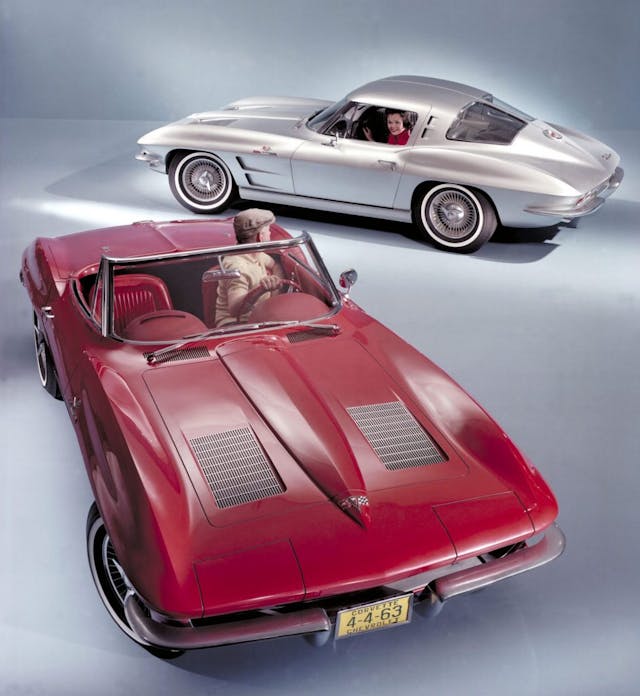
Then there were the looks. It’s easy to get desensitized to mass-produced automobiles, and each new generation of Corvette is not without its cheap details and gimmicky flourishes, but the stylists (under the leadership of Bill Mitchell and Larry Shinoda) really hit it out of the park with the C2’s basic shape. The pointed creases at the tops of the fenders, the lines of the fastback, and the sharp lamp-less nose with its nearly hidden grille made it unlike anything on the road in 1963. Or since, really. Car Life magazine noted that “[t]hey are unique, copy no trend and are exceedingly handsome,” while Car and Driver agreed that “it stands out from its European counterparts as having in no way copied them but arrived at the same goal along a different route.”
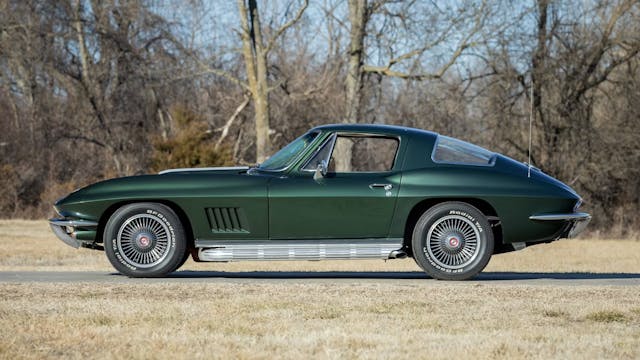
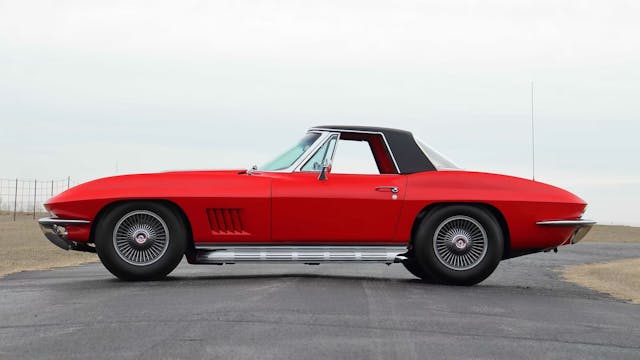
While it borrowed heavily from GM’s experimental 1959 Stingray Racer, this was the first Corvette designed as a coupe (though the convertible remained available) as well as the first one shaped with input from a wind tunnel. Like later C1s, the new C2 also had quad headlights, though in a first for a postwar American car, the Sting Ray’s were hidden by a rotating assembly. This would become a Corvette hallmark, and last until the introduction of the 2005 C6.
On track, the C2 mostly played second fiddle to the Shelby Cobra, but on the road it was a different story. Certainly in performance if not in refinement, the new Corvette matched most European GT cars. Zora Arkus-Duntov, the engineer behind the C2, boasted that “[f]or the first time I now have a Corvette I can be proud to drive in Europe.” Not everyone on the other side of the pond was so impressed, though, as Britain’s Motor Sport magazine griped that the styling, with embellishments like fake hood vents and split rear window was “as vulgar and over-ornamented as the [Jaguar] E-Type is simple and functional.”
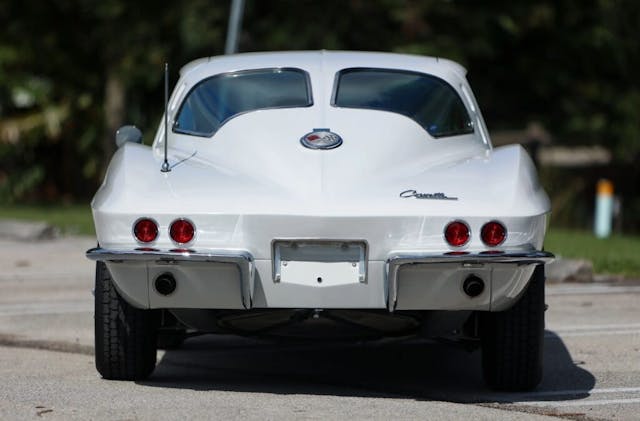
One particular design cue, that split rear window, was divisive even within the halls of GM. Designer Bill Mitchell loved it because it looked good. Engineer Zora Arkus-Duntov hated it because it blocked the driver’s view. Duntov won out as the 1964 Corvette went to a single-piece glass design out back (and got rid of the fake hood vents). Ironically, a ’63 coupe is worth more than the equivalent ’64 today by a wide margin.
Chevrolet sold 21,513 units for the C2’s first year, evenly split between coupe and convertible as well as up 50 percent from 1962. Four 327 engines, three transmissions, and six axle ratios were available. For the C2’s sophomore year in 1964, there were the aforementioned changes to the hood and rear glass as well as fewer ribs for the rocker trim, and improvements to the suspension.
Bigger changes came for 1965. The hood smoothed out and three tall vertical vents came in behind the front wheels. New engines arrived, most important among them being the Corvette’s first big-block, a 396 cubic inch monster rated at 425 hp and codenamed L78. This spelled the end for the 327/375hp Fuelie, the previous range-topper. Few people were enamored enough with fuel injection to spend more money for a slower car than the L78. Injection eventually returned to the Corvette lineup in 1982. Last but not least was the very welcome addition of four-wheel disc brakes, as even the optional sintered-metallic-lined drum brakes of early C2s weren’t up to the task of stopping a big-block. For 1966, that big-block further fattened up to 427 cubic inches and came in either 390- or 425-hp ratings, while the B-pillar on coupes lost its fussy-looking extractor vents.
Which brings us to 1967 …

For starters, a C2 Corvette in 1967 wasn’t supposed to happen—the new C3 was due out that year. Aerodynamic headaches with the next gen’s bodywork, though, resulted in a 12-month delay. By then, the C2 Corvette wasn’t the same fresh face it had been in 1963. The pony car segment exploded, and while Chevy’s two-seat flagship had no direct competitors in the showroom, two upstarts by the name of Camaro and Firebird did offer cheaper ways to go fast. But despite existing in a more crowded field and essentially serving as a carryover, the ’67 Corvette became the best of the breed.
External changes were subtle but enough to easily distinguish the C2’s final year from the rest. A “wolf in wolf’s clothing,” said the promo materials. Most obvious are the five small front fender vents, while a central reverse light above the license plate was added out back. On convertibles, buyers could specify the hardtop with black vinyl covering as was then fashionable, and on 427-powered cars there was a new one-year-only “stinger” pseudo-scooped hood. Ventilated steel “Rally” wheels came standard, while the optional centerlock cast aluminum wheels were now bolt-on and replaced the old spinners for safety reasons. On the inside there was new upholstery, the parking brake handle moved to between the seats, and the cowl on the passenger’s side lost its grab handle. Base price for this final and most refined C2 was $4240.
Technically the top dog in 1967 was the L88 engine option, which essentially got you a slightly stripped track-worthy car powered by a high-compression race engine. But there were just 20 of those built, and today they’re on a different plane of existence when it comes to collectibility. For the average motorist going ’Vette shopping in 1967, the top choices were a trio of 427s, themselves fed by a trio of two-barrel carburetors perched under a triangular air cleaner. This latest “Tri-Power” system detected vacuum through the center carburetor and opened the other two carbs gradually as the throttle demanded more air and fuel. Car and Driver called it “astoundingly tractable” with an “uncannily smooth engine response … as smooth and responsive as fuel injection.” Since Oldsmobile and Pontiac had discontinued their own triple-carb setups after 1966, this was GM’s only such system.
This range of triple-fed 427s started with the 400-horse L68. For $437.10 buyers could get the L71, which came with solid lifters, 11:1 compression, and a 435-hp/460 lb-ft rating. The L89 option then took the L71’s cylinder heads and swapped them for aluminum, but at $368.65 it was a steep ask and just 16 buyers went for it in 1967.
Car and Driver readers voted Corvette “Best All-Around Car” for 1967, and the magazine called it “the most sophisticated passenger car made in America … and among the best engineered sports cars made anywhere.” Testing a 427 coupe, the magazine also recorded a 0-60 time of 4.7 seconds, a feat that’s still pretty quick today and mind-blowing 56 years ago. That didn’t help sales, though, and in 1967 Corvette sales fell to 22,940, their lowest level since 1964. Maybe people were waiting for the new C3. These days, though, the 1967 stands along with the 1963 Split Window as the most beloved C2 while having its ’63 predecessor handily beat on performance.
3754 L71s were produced—considerably more than the L88 and L89, but not exactly garden-variety numbers, either. When well-equipped, the L71’s sticker could add up to around $6000, or just under $55,000 today. For context, that’s about the price of a nicely-equipped new Camaro SS.
The C2 lasted just five model years, and it remains the shortest-lived ‘Vette so far. It also came in only two body styles, but the available engines, paint colors, interiors and options can be dizzying and create a tremendous amount of valuation variation. Narrowing the focus to 1967 enables a bit more clarity.
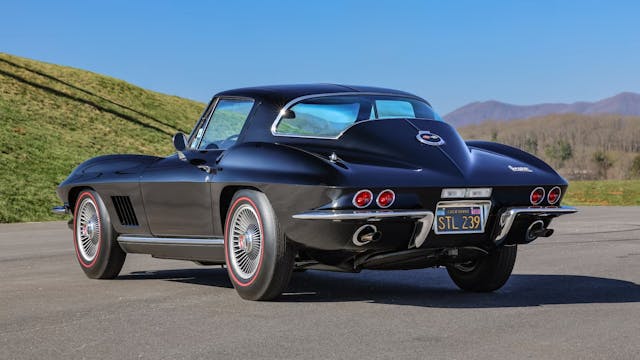
To be up front, no 1967 Corvette is cheap nowadays. Excluding the mythical L88, the model year’s average condition #2 (“excellent”) value is $135,000, well above the $94,600 average across the whole C2 generation. Values for ’67s range from $42,700 for a base 327/300hp coupe in scruffy #4 (“Fair”) condition all the way up to $540,000 for an ultra-rare L89 in #1 (“Concours”) condition, while an L71 coupe runs from $97,600 in #4 condition to $231,000 in #1, and an L71 convertible from $95,600 to $265,000.
Options make a difference, though, and this is more true for vintage Corvettes than nearly any other classic car we can think of. Pricing notes for C2s in the Hagerty Price Guide include -10% for a Powerglide automatic (when available), +$5K for factory air conditioning (when available), +$12K for bolt-on aluminum wheels, +$5K for 36-gallon fuel tank, +$1800 for leather upholstery, +$2500 for power steering, and +$2000 for side exhaust.
Like many high-end American cars, 1967 Corvettes took a serious dip with the onset of the Great Recession. They have since clawed their way up past pre-recession levels except for the L71, which has traditionally been among the most volatile as well as the most expensive of the C2s we regularly see on the market. These cars are also, unsurprisingly, favored by the oldest collectors and enthusiasts. Credit the high cost of entry and the 60-year-old build date.
Long held in high esteem among the bowtie brigade, C2s have been valuable for a long time despite their prolific 117,964-car run. It isn’t particularly hard to find a ’67 in the right condition. Many are quite clean. The important part is finding one with the right options for your wants and needs, for the right price. And since certain option combos carry big price premiums, ’67 Corvettes are one of those cars where authenticity and documentation (build sheets, tank stickers, certifications, etc.) are pivotal. With cars this expensive with details that matter this much, ensuring authenticity can be the difference between a car stealing your heart and breaking it. Consulting an expert is one of those things buyers never really regret, and luckily the community around classic Corvettes is big enough that there will likely be just such an expert near enough to either you or the car.
Aside from calling in for backup, things to look out for when ’67 shopping include the usual stuff like rust. The bodywork may not be metal, but nearly everything underneath it is, and rust-prone areas include the main frame rails, between the rear of the doors and the rear wheels, and inner door frames.
One of the more appealing things about owning a classic car built by the General is parts support. Both small- and big-block V-8s are cheap and easy to rebuild. Same goes for the transmissions. Many of the interior pieces are easy to find as well, while the headlights and some year-specific trim pieces are a little harder.
An L71 occupies an odd place in the market. They’re definitely expensive. There are way cheaper ways to get the crossed flags on your keychain, as well as far cheaper means of going much faster. Then again, Corvettes always offer good value no matter what price point we’re looking at—think of what all the other top-level sports cars from the late 1960s (Cobras, Ferrari Daytonas, E-Types, etc.) cost these days. These last, most refined, prettiest, and quickest versions of America’s sports car’s most celebrated era are high up the Corvette food chain because they deserve to be.
***
Check out the Hagerty Media homepage so you don’t miss a single story, or better yet, bookmark it. To get our best stories delivered right to your inbox, subscribe to our newsletters.
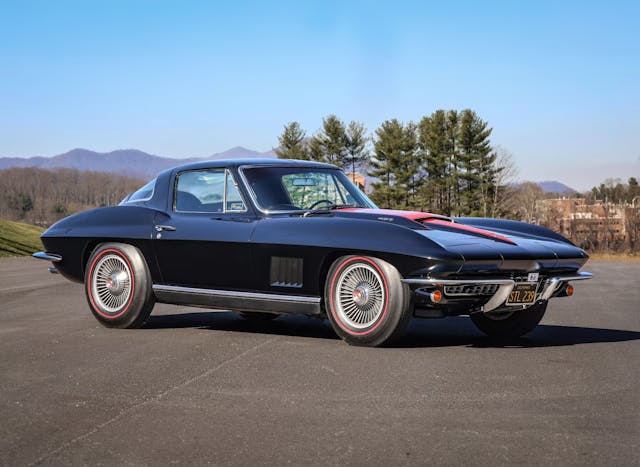
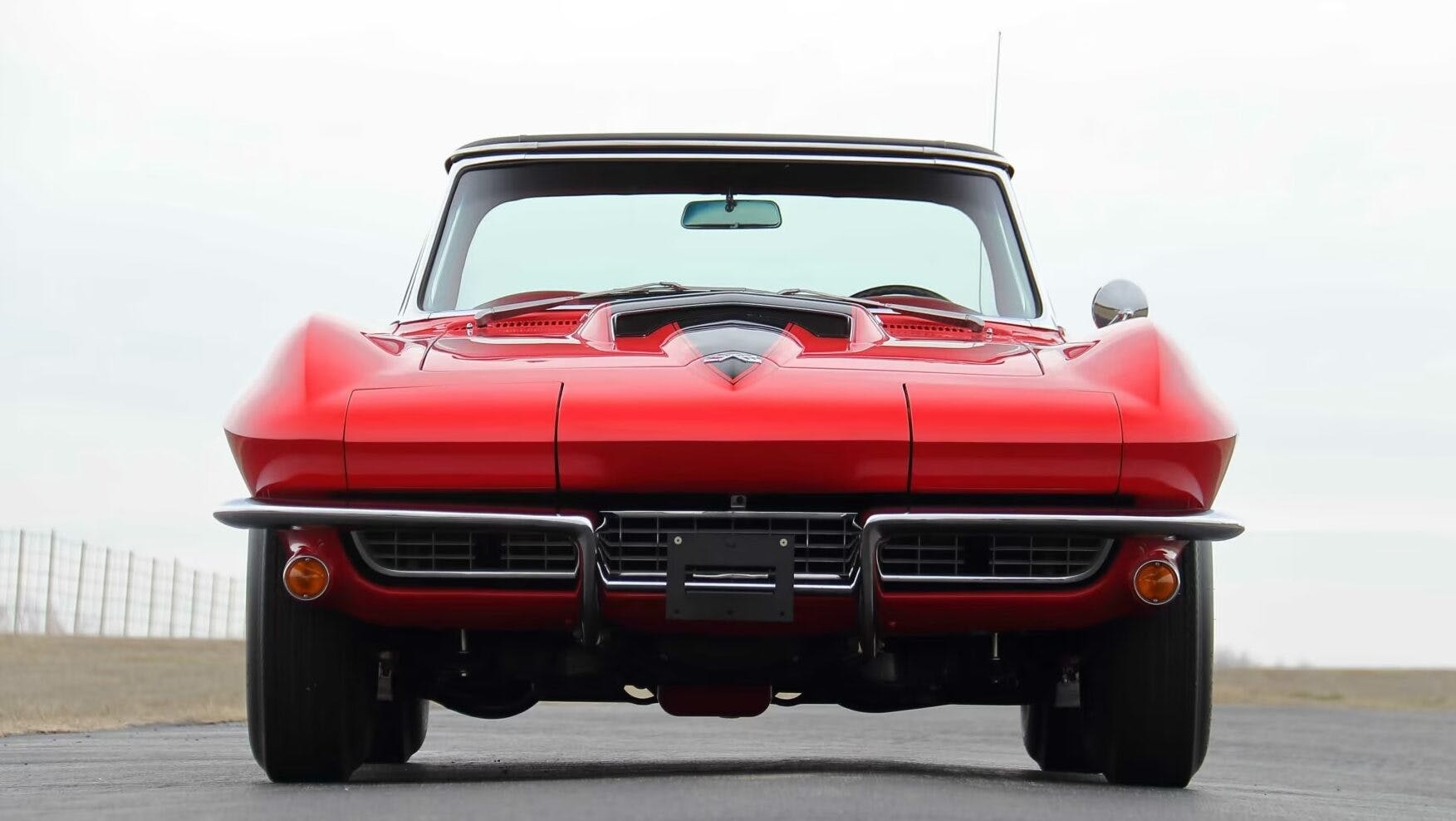

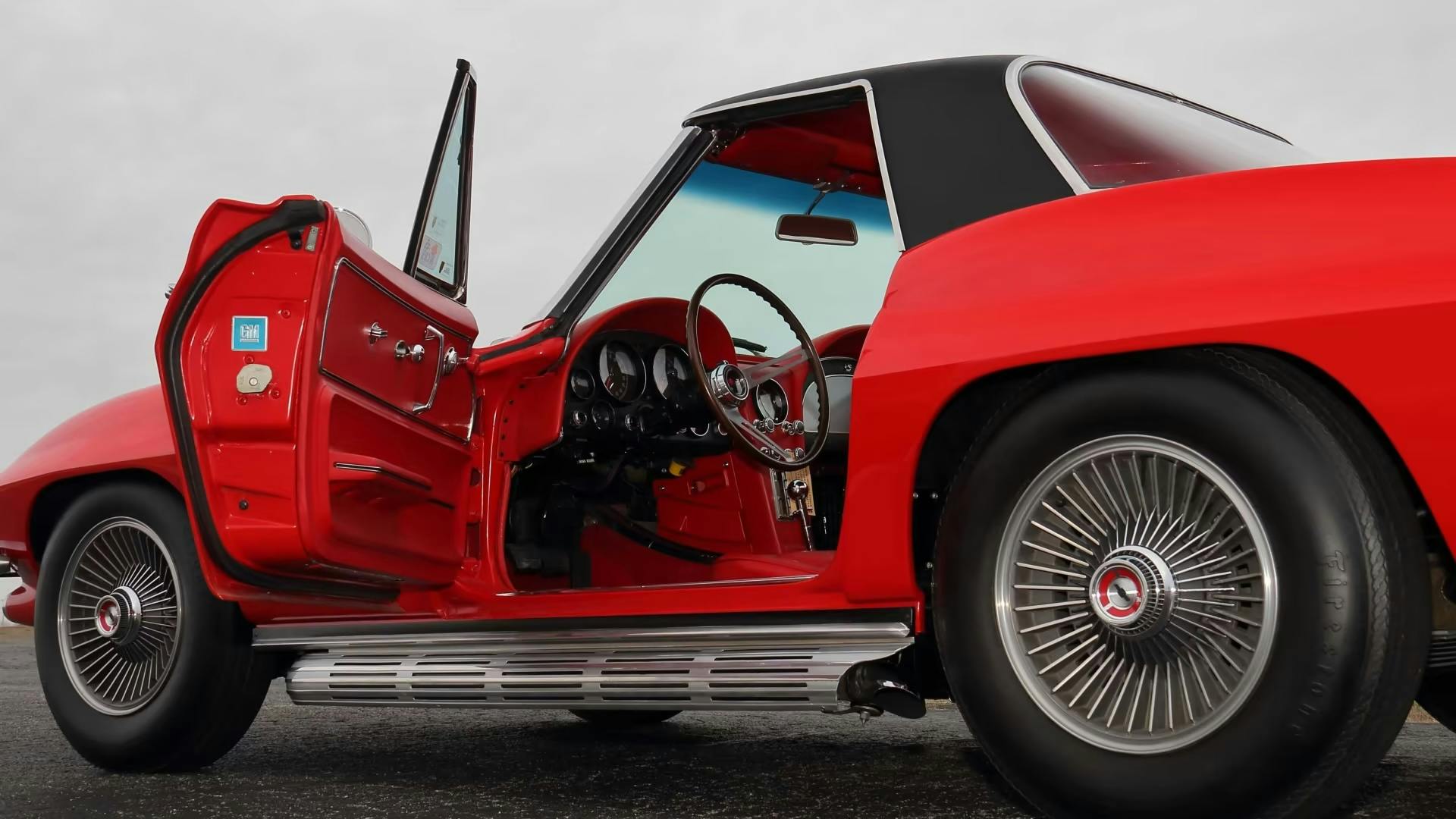

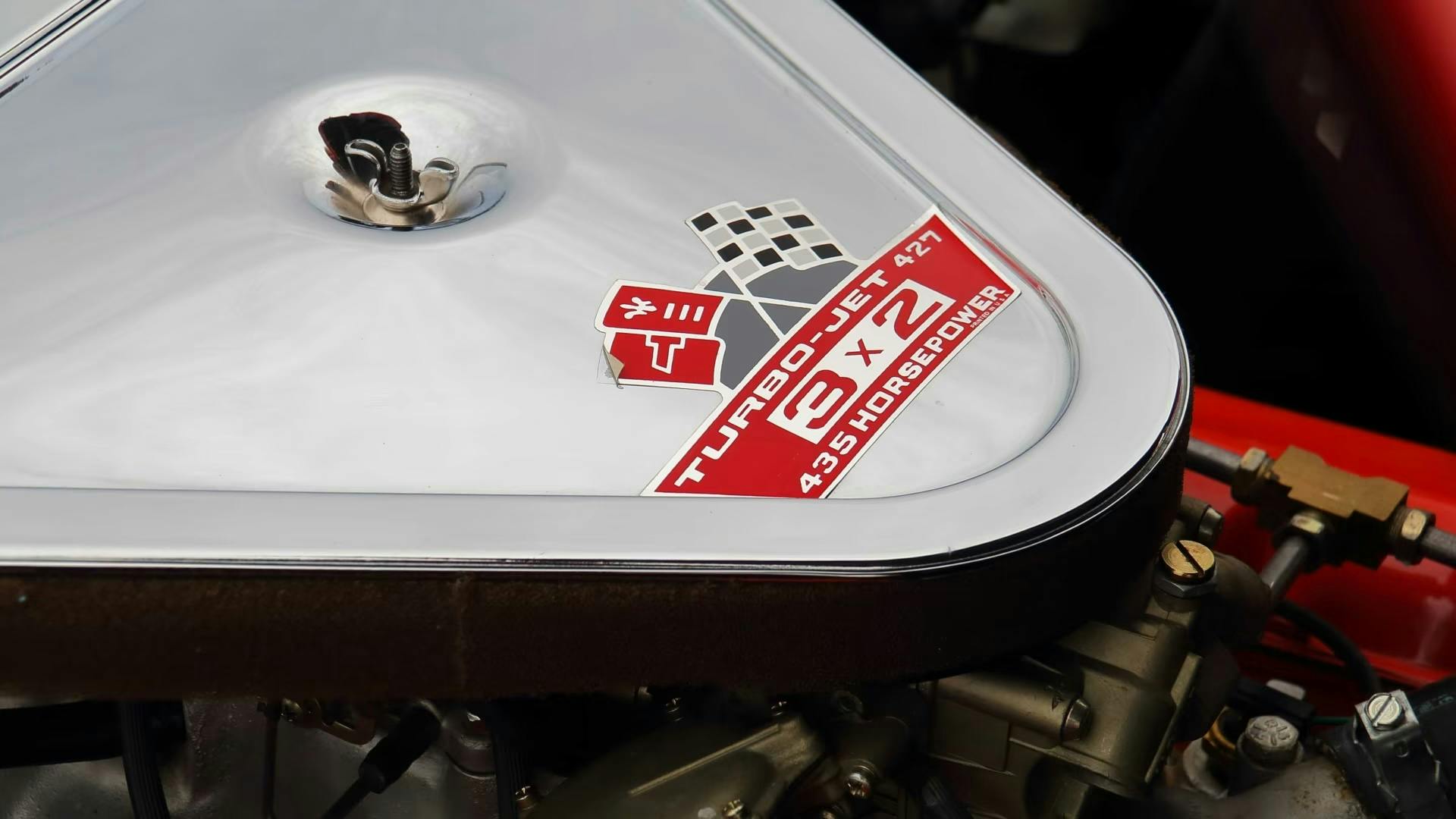
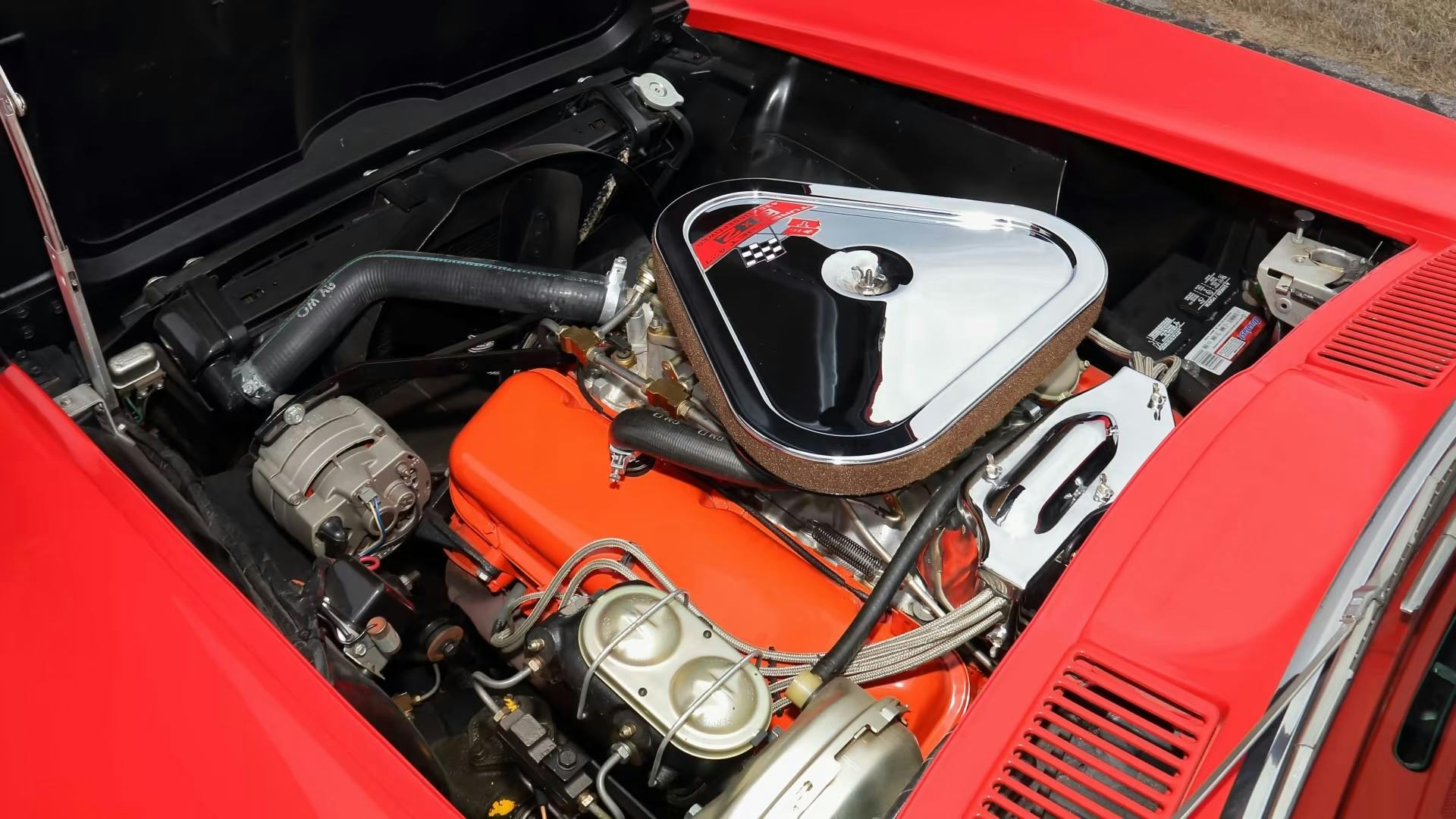


Let me first say I love this car and the C2. But there was a major flaw with this car that it struggled with back in the day that many like to forget.
While styling was striking it was horrible for racing. The car was everything in the nose you don’t want for lift. The Grand Sports were reported to lose steering at high speed and Penske added a big air dam to stop the lift.
As the chassis went to the C3 GM missed a real opportunity to put a new chassis under the car that would have moved it forward as the C2 did from the C1. It took till 1984 till it got the chassis it needed to catch up and then finally move ahead in 1997.
These have always been fun cars and today it is the joy of a sports car but yet with a very vintage feel. The only down size is the prices are no longer to where people even drive many of these anymore. They are becoming a rare site on the streets.
Where I work is a large company today and it was started by buying parts for a 67 Corvette. I have been there 30 years now with a very rewarding career and it was due to a man with a vision and a big block Corvette.
I returned from 2 years in Vietnam in August of 1966. I had never gone on Rand R and h ad saved my money. I was an E5 with 7000 dollars. I had 2 goals upon separation from the Marine Corp. 1. Buy a 1967 hipo big block Corvette. 2. Go to college and get a degree.
First things first.
At that time if you in the military you could contact a military auto broker an d thru him factory order a new car. From any USauto manufacturer to your spec with a huge discount off MSRP. I FOUND A REPUTABLE BROKER in Oklahoma City and ordered one.
The spec I chose was 427 435hp tripower. Mandatory transistor ignition. AC not available. MAndatory M21 close ratio 4 speed trans.
I ordered a 3.36 posi rear end . F41 suspension. Leather seats. Black on black. Redline tires. Power windows.
Sticker price 5800 dollars. My price thru the broker 4585.00 FOB Oklahoma. Due to a strike the car wasnt delivered till Dec15.
I drove my new Corvette from Oklahoma City to Steamboat Springs Colorado observing all breakin procedures. It used a lot of oil a quart every 500 miles.
Therecwas a small Cgev dealership in town. They were used to selling pickup trucks. My Corvette was a novelty . At 2500miles the Corvette was still using too much oil. The Zone Rep was called and agreed to a teardown to find out why.Teardown was commenced and the cause was found early on. The intake manifold bolts hadnt been torqued down. That was remedued and the car immediately ceased using excess oil and went to consuming around a half a quart every 3000 miles.
I hadnt ordered the car for drag racing but for highway driving and top speed. Nevertheless the Cirvette was probably the fastest csr in northwestern Colorado at that time.
I spent the summer in Steamboat and was lucky enough to get a scholarship to a college in Menlo Park California where I moved to in August of 1967.
My Corvette would runout at around 153 mph at redline of 6500. The steering was lighter at that speed but not dangerously so.
The big disappointment was the redline tires.they were dangerously inadequate for the amount of power I was putting down. A quick 1 to 2 shift would put the car sideways at 60mph. E c citing but unrewarding.
I remedied this by replacing the wheels with wider cusim offset American 5 spoke aluminium wheels and Goodyear Bluestreak tires. They werent good in the wet but worked well on dry pavement.
At college in California the hot car craze was in full swing. There was the usual assortment of hot cars with rich kid owners. Only one car was competive with mine . A kid out o f Texas with a blue 68 and the L89 engine with the aluminium heads. He was running a 3.36 posi rear also. Therecwasca dragstrip in Fremont atthe time. Using normal drive it o f f the line and no powershift I could go thru the lights in 13.06 at 107mph in second gear at 6600rpm.
His best was 13.15 at 105 in second gear at just over 6500 rpm.
One day in the spring of 1969 a high school kid showed up on campus with a new Boss 429 Mustang.
He announced he had a car that was faster than any Corvette. Well… Carlie the kid with the 68 and I went out to look at it. It still had the windiw sticker that showed the car had a 3.5 posi rear. Charlie and I flipped for the privilege. He won the toss. The race was to start in San Mateo go thru a twisty 2 lane over the coast range dump out on Hwy 1 with a straight run of around 20 miles into Half Moon Bay. The bet was 500 dollars a considerable amount in those days.4 of us backed Charlie pot to be split 5 ways.
The Mustang hooked up better than Charlie and took the lead going into the first of many curves. It handled surprisingly well…good enough that Charlie couldnt get ariund him thru the mountains. I was waiting where the 2 lane dumped out into the 4 lane coast highway.
Charliecwas about 50 feet behind the Mustang went around him and passed in 2nd gear and was just gone. Charlie said he was running at 155 at 6500 all the way. There was virtually no traffic since it was 0030 hrs in the morning.
I didnt do muchvstreet racing and when I did it was from a 20mph roll since I was aware that the rearend in the Vette was the weak link in the car. From a roll the car was ALMOST unbeatable since I only had to shift once thru the quarter.
I was beaten once by a 1968 Canaro running 396 insignia. It was owned by a rich high school kid out of Atherton who had bought and transplanted an L88 engine into the Camaro. It was running 4.11 gears and the kid knew how to drive it. We went from a roll but it didnt matter. I got beat by around 6 or 7 car lengths.
It was good times. I had to sell the Vette to go to grad school .
After grad school I got a job and subsequently owned two other 427 435 hp 67s. I also eventually built a 1965 F I. Corvette convertible that was making about 405 hp.
F I r my money the apex Corvettes up to the C6 Z06 were the hipo 67s and the 65 FI.
Damn brother! That was a great comment! I was a street racer and occasional grudge night attendee at Fremont when I was 19 years old (1964). What great memories of cruising The Strip in San Leandro every weekend. Virtually a race or pretty girls at every stoplight. 😉 Rumbly cams and glass packs. I used to cruise First Street in San Jose (I was a student at San Jose State) and El Camino occasionally. When I saw American Graffiti at the drive-in with my wife in our ’72 240Z I almost wept from nostalgia. I live in suburban Sacramento now and have run two of my cars at Sacramento Raceway (recently closed 🙁 ). I’ve been a car nut all my life. Still got a ’69 Mustang convertible, a ’95 Bronco XLT and an ’09 Corvette. Do you still street race occasionally? I do!
I am reading this for the second time. What a life. What a car. By the way, thank your your service. I separated from the US Army in July 66. Merry Christmas.
It all sounds just right. I bought my 67 L71 Coupe from The Buggy Works in Pensacola, Fla when in Navy pre flight school. Goodwood Green over tan interior. Just a week ago I signed it over to my son who is very deserving. It came with 3.55 rear gears but I traded rear ends with another C2 owner who had 3.08 gears. I like high gears. 75 in 1st, 100 in second. Even with that, I turned a 13.66 at 110 in Gainsville with the stock aircleaner and stock under car exhausts. Using a speed/weight/horsepower nomagraph for the 1/4 mile, it calcs out to 425 HP at the rear wheels.
For many years it was my only car and I drove it anywhere anytime sun, rain, snow and ice. It now has an estimated 220,000 miles on it. Odometer quit at 75,000 or so. I made many small changes to it to make it easier to work on and more to my liking. Nothing major, all very restorable but still a good driver.
All in all, it has been a very good experience.
Why does the chart and the article not pay much attention to the L68 427/400 tri-power cars (shows an L36 four barrel car)? The L68 had the same peak torque at lower rpm as the L71, and was infinitely more friendly on the street (no solid lifters to constantly adjust). Can you add that info please.
I had a ’69 L36 coupe and the L68 was the same engine with the same cam and heads with the exception of added venturi area with the 3×2 carbs. And it only had 10 more horsepower per Chevrolet. Actually, I owned an LS1 powered Z28 at the same time I owned the L36 and the Camaro would have sucked the Vette’s doors off in a head-to-head drag race. I never took the Vette to the drag strip (respect for an original numbers matching car) but my Z28, with a 4 speed automatic, 2.73 gears and street tires, ran a best 13.44 @ 107.43 mph. The vintage magazine article that I got with the Vette from the P.O. showed an e.t. of 15.02 @ 92 mph. My ’69 Mustang convertible with a 302 (modified) and a C4 automatic has run quicker and faster (14.308 @ 99 mph).
A couple of more paragraphs on the small block offerings would have been nice.
The small block cars were probably better handling true sports cars. My ’69 427 coupe was nose heavy and would plow in hard turns despite being equipped with the F41 handling option.
Seems always talking about Corvette beautifully cars never a mention about gnx,gs they were a force on the streets just not a lot of interest I suppose sure wish I had my Riviera gs fantastic highway star with style.. any out there ?
Alas, I have to agree. I bought a ’69 427/390hp, M21 4 speed coupe in 2004. I remember telling my late wife that it was too bad our Vette wasn’t two years older because it would be worth a whole lot more. BTW, my ’69 was an unmodified, low mileage (69K), numbers matching car with all the original equipment right down to the stupid air pump. It was LeMans blue with a black interior. It won a ton of first places in regional Corvette shows in C3 Stock class after I had it paint corrected. It was also probably one of the most uncomfortable vintage cars I have ever owned. It didn’t even have enough room for luggage for two or a set of golf clubs. I auctioned it off in 2011 in Monterey because my wife hated the car.
I have never appreciated all the hoo-ha about ’67s. They look like what they are: second-rate leftovers because the factory could not get the new C3 models market-ready in time. In fact, the ’68s weren’t even worked through design-wise until the ’69s arrived, viz the half-baked exterior door handles and evident rushed assembly. But back to the ’67s. Design-wise the ’65s and ’66s have it all over the ’67s. The ’67 side vents are fussy; the back up light looks like it came from J.C. Whitney; the knock-offs lack the sexiness of the spinners and the teak steering wheel was dropped. One can argue that new laws forced some options to leave the scene, but the result’s overall appeal declined nevertheless. As for performance, what this design really did not need was more power. The car’s front end floats way too much at high speeds. The tires of the era were scary as hell to pilot on curves. Then there’s the practicality issue. C2s can run hot. Add A/C and the heat problem is compounded. The factory got so desperate to keep C2 big blocks with A/C coolish that they repositioned the front license plate to the right side of the grille. It was a nice try. The interiors could get toasty anyhow. If you want a balanced, beautiful C2 get a ’65 or ’66 small block–those are the zenith C2s.
Sorry Richard ! I beg to disagree ! I have owned several `67 big blocks with Fact. AC, and only once- in 90+ degrees and bumper to bumper did I ever see the Temps rise up more than comfortable on the Factory Instrumentation, and it dropped quickly as soon as i turned the AC off. The ONLY `67 models that had the center license tag mounts shifted to the left of center grill were the ones ALSO equipped with automatic transmissions, and Fact. AC !! Belivev it was to help cool the tranny. Anywho- made money everytime I owned one, enjoyed driving the heck out of them, and still think they are the absolute most beautiful of the C2`s ! I now own a `06 ZO6, and a `17 ZO6 w/7spd. manual, only because my `67 BB Fact. AC Vettes had gotten TOO expensive to drive !! I want to USE them! Sinc., Sackboy
I owned a L -36 1967 for 11 years , NCRS top flight twice car. Frame was over built but the rest of the car fragile.
Frank – Sorry to correct but in the spirit of this time of year it’s not fragile it’s ‘fragil-ey’, must have been made in Italy. – ‘A Christmas Story’ – ” Oh fudge “
Joe —
I’m with you on the ’65 Fuelie, but I’m a bit of a philistine as I always thought Corvette went the wrong way with the big block as I believe it affected steering and weight distribution adversely. I guess I was right to some extent because the “rat” disappeared while the development of the small was carried to the point it is today.
Ken —
I’m an old fud who wanted to buy a ’65 Fuelie when I graduated from college, which I couldn’t afford it then. It took 24 years before I could but it was well worth the wait as now the gendarmes see this old gray head and think I’m harmless. However, I’ve found various European status symbols and souped-up Pacific rim glorified lawnmowers to be “meat on the table” at a stop light Grand Prix even from a standing stop. I also have the pleasure of blowing road dust and debris with the side-mount exhausts at those sweethearts on their high-priced Schwins in their cute shorts, shirts, socks, and helmets.
I grew up in NYC and had a 20 year old neighbor who lived in his parents basement. Seemed he bought a new Corvette every other year and I remember his 67 coupe. I used to help him wash it when I was a kid, like 4 years old. I thought that car was the coolest thing, marina blue as I recall. Then one day he pulled up in a yellow 68 with T tops. The neighborhood gathered around to see the thing up close. I was so disappointed that he had traded his 67 for this ugly thing and said so, which lead to the gang chasing me down to the beach and into the water where they threw rocks at me every time I came up for air. By 73 we had gas lines that were hours long and we used to move cars up for people as they had lunch in the nearby diner. I was 10 (the older kids sold the job for $1 and then “subcontracted” it to me when the owner entered the diner, then they’d go sell another job) So as a 10 year old, I got to drive cars up in the line for an hr or so. One day a guy comes up in a yellow 67 BB roadster with automatic transmission. It had a “For sale” sign in the window, asking $1000. Guy told me that he could not deal with 6 mpg and was gonna get a VW beetle. But the big kid who sold the job didn’t want to give this one up and moved it up the line himself. Mesmerized by the lines of the car and that black stinger hood, I opted to just sit in the passenger seat and feel the rumble of the motor and the sound of the side pipes as we moved that car along the gas line. I wrote the number down and as soon as the driver returned to finish the job I jumped onto my bicycle and flew home, begging my father to buy the car and hold it for me (in the driveway) until I turned 18. Fat chance. And so began a quest to own a 67 Big block corvette. Every monday I’d get the want ads and scour the classifieds looking for one and every time one came up for sale, I’d be off to have a look at it, under the car looking for rust or signs of accidents. I’d attend swap meets and talk to anyone that owned a mid year asking about what to look out for when I eventually bought one. Finally, at age 30 I had saved the money to buy a car, and so began a 2 year quest to find the right one. My tastes had matured from either red or black cars to the magnificent Goodwood Green, (most popular car by far in 67) but it had to be a 67 Big block. I’ll never forget the moment when I had found the car, made the deal and the owner tossed the keys over the hood to me. Time stood still as I snatched them from the air, a dream finally come true. I love driving the car on a windy country road, or to a cruise night and chatting with others about it. And I always let little kids sit in the car while their parents take photos. Maybe I can inspire some little boy to think big (block). Not for sale. https://www.youtube.com/watch?v=eBDF9N5_Qos&t=127s
I always thought the 67 Corvette was the most beautiful design ever conceived. Never had the wallet to obtain one but ended up with a C5 convertible which I absolutely love. I would still take a C2 over any other generation. Including the C8. Nice article!
C2 is among my favorite of all Corvette designs. I put the C6 Z06 as my second favorite.
I drove a C8 the other day, it didn’t impress me much to be honest especially for the money they were asking for it here in Australia (250,000AU). I expected wonderful things before I drove it, only to find it drove like every other US big V8. It felt like a big car to drive, not at all like the lithe sports car I was expecting from such a highly engineered machine, strange really as they are not all that heavy? I had driven to the yard in my locally produced F6 Typhoon with the 6 speed man box, and I can honestly say it felt good after the Vette which is rather damning when you think about it, with the Barra engine tweaked to around 500HP It also felt as quick if not quicker than the C8? I paid $41,000 for the Typhoon, I could six of them for the price of the Vette. Maybe I should save up for an Aston Martin Vanquish??
The F6 Typhoon was a nice sedan, like many other sedans that went well, but never-ever anywhere close to being in the same league as the top dog Vette.
For a street car it think you are much better off with a small block. What nobody is talking about is how much hotter a big block is inside the car. The C2 does not have a large gas tank so the poorer gas mileage of the big block gets tiring on a trip of any length. I have owned both big block and small block so I speak with some experience.